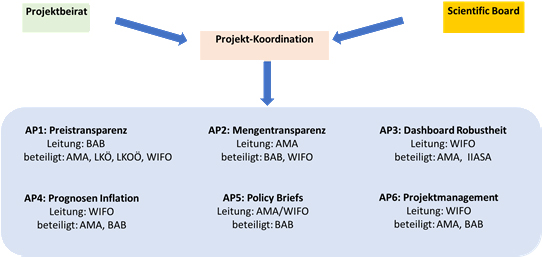Robust Food Supply Chains in Austria
The reliable supply of high-quality food to the Austrian population has become the focus of public debate in recent years, not least due to the large number of crises. As part of the cooperation project "Robust value and supply chains for agricultural goods and food in Austria" (ROBVEK), aspects of quantitative supply as well as the affordability of goods along the value chain were examined in a total of 6 work packages. The Federal Institute of Agricultural Economics focused on work package 1 (WP1) "Price portal - development, implementation and operation of a website to ensure price transparency" and work package 2 (WP2) "Transparency of available quantities of agricultural goods and foodstuffs in Austria".
Objective
The central objective of the project was to prepare available information, findings and data relating to security of supply in such a way that decision-makers can obtain a quick overview of fundamental developments in security of supply and, if necessary, take action. The information should be made available to all decision-makers, including farmers. In order to achieve this fundamental goal, the following sub-goals were defined, whereby the first two are primarily assigned to WP 1 and WP 2, which are being worked on by the BAB:
- Creation of an up-to-date internet presence to ensure price transparency;
- Development of a method that uses existing data sources to create transparency regarding the quantities available in Austria and the values along the agricultural goods and food value chain;
- Development of a prototype for a dashboard to show the robustness of international supply and value chains relevant to Austria;
- Development of a method for forecasting the inflation of food and energy products:
- The creation of a basis for decision-making and options for action on security of supply issues.
Project implementation
The project led by WIFO is divided into six work packages, with the BA für Agrarwirtschaft und Bergbauernfragen playing a key role in two work packages. The content and technical support of the project was provided by a project advisory board (client) and a scientific board (external scientists). The project ran from 01.09.2022 to 07.12.2023. The following figure provides an overview of the organization of the project and the institutions involved.

Project results (BAB relevant)
WP 1 Price transparency: Price portal - development, implementation and operation of a website to ensure price transparency
The price portal offers a collection of current, past and expected future prices of important agricultural and forestry goods as well as selected operating resources. It was developed, implemented, tested and improved with the involvement of users. The price portal is provided and maintained by the BAB and filled with data by the participating organizations (AMA, BAB, LK Niederösterreich, LK Österreich, LK Steiermark, WIFO). Even after the ROBVEK project is completed, the price portal will be maintained and updated with the latest data. It provides a clear information basis for various user groups - including agricultural businesses, advisory services, public administration, research and education. The price portal comprises the database, data transformations, interfaces and online application:
- The database contains the data from the now-defunct website www.landnutzung.at/preise.html, relevant data from the BAB data pool, relevant data from publicly accessible sources, raw data entered by data suppliers via interfaces, (e.g. technically) processed data and metadata. The database provides information for the user interface.
- Raw data is prepared and aggregated, data is validated and data from different sources is combined in the data transformation area.
- The interfaces can only be used by the data suppliers at the end of the ROBVEK project. They are used to enter data into the database (via freely definable data pipelines) and to read data from the price database (via web service)
- The online application is available to all users at https://preise.agrarforschung.at/. The user interface is divided into the sections Animal products, Plant products, Wood and wood products, Price indices and Farm inputs. The price information is provided in the form of interactive graphics, which can also be saved locally. The data stored in the graphics can be saved and edited locally.
WP 2 Quantity transparency: Transparency of available quantities of agricultural goods and foodstuffs in Austria
The aim of WP 2 was to analyse and visualize (Sankey diagrams) the material flows between the actors in the value chain for a selected sector (pork) on the basis of a pilot project, to identify data gaps and to examine the transferability of the form of presentation to other sectors. The starting point for this was the quantitative analysis of material flows. Building on this, considerations were also made regarding the value-based representation of the value chain. Key work steps included database and literature research, the preparation and merging of various data sets in as consistent a form as possible, the closing of data gaps by means of targeted research and expert interviews, the creation of a data set as a basis for the presentation of material flows and the development and implementation of a material flow model as a Sankey representation. The data from the supply balance, the foreign trade database and special evaluations of the Roll-AMA and Gastro-Panel data formed the basic framework for the most continuous and consistent representation of material flows possible. The latter enabled a more differentiated view according to purchasing sources and product groups. The analysis of the data sets also highlighted the need to update factors and estimates for calculating variables in the supply balance (e.g. factors for calculating the proportion of pet food, industrial use). On the other hand, major data gaps were revealed, for example in the area of animal by-products or losses along the value chain. These should be closed as part of further work.
All project reports are available on the "DAFNE" research platform: https://dafne.at/projekte/robvek
Translated with DeepL.com (free version)













